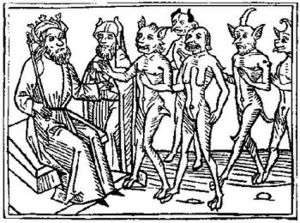Consolatio peccatorum, seu Processus Luciferi contra Jesum Christum is a tract written by Jacobus de Teramo in around 1382.[1] It discusses a lawsuit between Lucifer and Jesus Christ, Solomon presiding, in which the Devil is suing Christ for having trespassed by descending into Hell.This work was printed repeatedly and translated into several languages.[2]

Description
editIn fact "Consolatio peccatorum", describes not one, but two trials between Lucifer and Jesus Christ, before a tribunal presided over by Solomon, in which the devil pursues Christ for having committed an intrusion into his domain during his descent into Hell. At the first trial Moses is counsel for Jesus Christ and Belial for the Devil. At the second trial the Patriarch Joseph is judge, Aristotle and Isaiah defend Jesus Christ, and the Emperor Augustus and Jeremiah defend the Devil. In both trials the decision is in favor of Christ, but at the second trial the Devil is granted the right to take possession of the bodies and souls of the damned at the Last Judgment.[3]
The work must be seen as an allegory to the historical events of the time: the descent of Jesus into hell and the liberation of the Patriarchs is a metaphor of the end of the Avignon papacy and the return of the papacy to Rome (in 1378), the subsequent reaction of the demons is represented by the antipope (Satan). The solution proposed by Paladini to resolve the dispute between Satan and Jesus, namely to entrust the cause to an impartial tribunal of arbitration, is the one adopted to resolve the schism of the West, with the convening of a council - the first in Pisa (1409), but without success, then at the Council of Constance - which obtained in 1415 the resignation of Pope Gregory XII, overthrew the antipope Benedict XIII of Avignon, and elected Pope Martin V to the papacy.
Editions
editThis work has been printed several times and translated into several languages. An early edition is in German and was printed by Albrecht Pfister in Bamberg in the 1460s.[4]
it was printed at Augsburg in 1472 as Das Buch Belial , illustrated with woodcuts in 1473, and, although subsequently, the work was listed on ' Index librorum prohibitorum,[5] Gerard Leeu printed another edition in Latin in Gouda, 1481.[4]
It was also printed again in 1611 at Hanover, under the title Processus Luciferi contra Iesum coram Iudice Salomone.[6]
References
edit- ^ D'après la biographie italienne (Treccani) il serait mort à Spolète ; le décret de nomination comme légat en Pologne concerne une autre personne et dante de 1419.
- ^ Jacobus de Teramo ab Ancharano: "Liber Belial" Entrée de catalogue
- ^ Jacobus de Theramo. "[Consolatio peccatorum seu processus Belial] ([Reprod.]) / [Jacobus de Theramo] ; translate par frère Pierre Ferget". Gallica (in French). Retrieved 2024-02-05.
- ^ a b J. Victor Scholderer (1912). "'Albrecht Pfister of Bamberg' (book review)". The Library. S3-III (10): 230–6. doi:10.1093/library/s3-iii.10.230.
- ^ Jacobus de Teramo ab Ancharano: "Liber Belial"] Entrée de catalogue
- ^ Jacobus de Teramo ab Ancharano:
External links
edit- Jacobi de Ancharano (alias de Teramo): Litigatio Christi cum Belial German translation with pictures - BSB Cgm 48, [S.l.], 1461 (pictures Belial at hellhole, Litigatio Christi cum Belial)
- Jacobus de Teramo: Liber Belial De Consolatione Peccatorum Vicentie, 1506